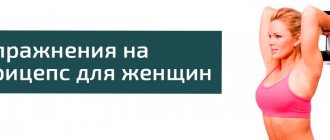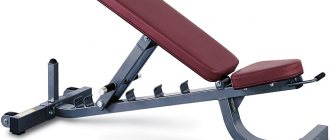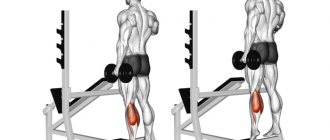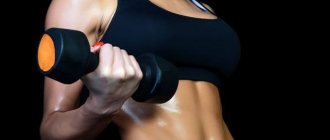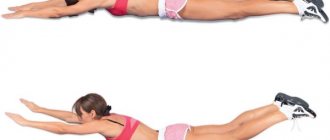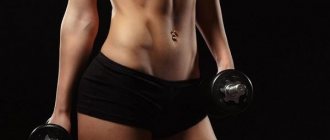Why do you need to pump your arms?
Yes, in fact, it is not necessary and not particularly necessary to pump them up :), because they make up 5-7% of all muscle volumes of the body, so theoretically they cannot give any significant increase in weight.
Often, many training programs, for example, for ectomorphs, completely exclude this muscle group or devote the least time to it. Of course, the hands are involved in almost all movements and receive their load indirectly, but still it cannot be compared with targeted and highly specialized work. Therefore, you need to shake your hands, at least for this reason:
- As various surveys show, ladies pay significant attention to their hands. In muscular arms they feel the strength and ability to protect and not allow them to be offended;
- pumped up arms look good in summer in various sleeveless T-shirts - this is a sign of good physical shape of their owner;
- when you are asked to show your pumped up muscles, you always show your biceps;
- in the men's world, volume matters, so if you have weak hands, then the attitude towards you is appropriate;
- strong hands are the ability to resist holds/choke and deliver a crushing blow to an opponent;
- for women, toned arms and strong forearms/hands are a plus in everyday life, such as carrying bags or carrying a child;
- for women - this is the absence of jelly and various sagging under the arms;
- If you have muscle-toned arms, you can afford sleeveless and open-shoulder dresses.
Anatomical atlas of arm muscles
The arm muscles have many large, externally visible muscles that help us in everyday activities, such as changing clothes or using a PC.
The muscles of the upper limbs are divided into:
- shoulder muscles, which in turn are divided into the anterior group (flexors) - brachialis, coracobrachialis, biceps and posterior (extensors) - ulna, triceps;
- The muscles of the forearm are the largest, these are the brachialis (brachialis) and brachioradialis (brachiradialis).
From the point of view of occurrence, it is customary to distinguish:
- superficial (clearly visible on the surface) – biceps, triceps, brachyradialis, long extensor carpi radialis, deltoids;
- deep muscles - lie deep on the surface.
The muscles of the upper arm are responsible for flexion/extension of the forearm at the elbow joint. Flexion of the forearm is achieved by a group of three muscles - the brachialis, biceps and brachyradialis.
In general, in the literature on anatomy it is not customary to translate the names of muscle groups, i.e. there, for the preservation of the original Latin names, for example, brachialis will be musculus brachialis. In this regard, a more correct “Latin anatomical picture” of the arm muscles will look like this.
Let's look at the major large muscle units individually.
No. 1. Biceps
The large thick fusiform brachii muscle is located on the upper part of the humerus, consisting of 2 heads - long and short. Both originate in the shoulder area, attach below to the round eminence of the forearm bone, and unite in the middle of the shoulder.
The biceps performs the following functions:
- works as a forearm supinator by turning and moving the palm upward;
- flexes forearm/shoulder;
- flexes the upper arm (raising the arm forward and up).
No. 2. Triceps
The triceps fusiform muscle lies on the back of the shoulder. It has three heads - lateral, medial and long, which merge on the olecranon of the ulna. The lateral and medial heads of the triceps originate on the humerus, the long head begins on the scapula.
The triceps performs the following functions:
- extends the elbow joint/helps straighten the arm - acts as an extensor of the forearm at the elbow joint and humerus at the shoulder;
- The long head also assists the latissimus dorsi during the bench pullover exercise, bringing the arm down toward the body.
Summarizing the “head” muscles, the combined anatomical picture of biceps + triceps looks like this.
No. 3. Forearm muscles
The most famous and largest muscles of the wrist are: brachialis, brachyradialis, flexor carpi radialis longus and coracoid muscles. Let's look at them in more detail.
3.1. Brachialis
Most of the muscles that move the wrist, arm and fingers are found in the forearm - they are thin, like a strap. The brachialis is a flat, fusiform muscle that lies under the biceps on the lower anterior surface of the shoulder. The beginning is attached to the bottom of the humerus, and the “end” is attached to the bony eminence of the forearm.
Brachialis performs the following functions:
- the main and strongest ulnar flexor - responsible for bending the elbow in any position of the hand (supination, pronation, neutral).
3.2. Brachyradialis
This is a fusiform muscle located on the front surface of the forearm. Originates at the lower outer part of the shoulder, crosses the elbow and extends to the radius (outer lower part). To see the muscle, tense your forearm and move your thumb to the side; the brachiralis will “appear” near the elbow, closer to the biceps tendon.
The brachioradialis muscle performs the following functions:
- bends the elbow;
- plays an active role in the up/down rotation of the forearm.
3.3. Extensor carpi radialis longus
On the back of the arm are extensor muscles such as extensor carpi ulnaris and extensor digitorum longus, which act as antagonistic flexors. The extensors are somewhat weaker than the flexors.
The extensor carpi radialis longus muscle is located next to the brachyradialis and is one of the 5 major muscles that help move the wrist. When a person clenches a fist, this muscle is actively involved and protrudes from the skin.
3.4. Coracobrachialis muscle
A long, narrow, beak-shaped muscle located on the inner surface of the shoulder. At the top it is attached near the coracoid process of the scapula, and at the bottom - to the front inner part of the arm. This muscle is not an elbow flexor
The coracobrachialis muscle performs the following functions:
- bringing the arm toward the body with the elbow bent.
A composite atlas of all the muscles of the forearms looks like this.
Actually, we're done with anatomy. Friends, are you still here...or am I just shaking the air? :). Let's go further and now talk about practical training aspects.
Supination and pronation - what is it?
These are two special movements produced by the muscles of the forearms - supination (turning outward) and pronation (turning inward). Supination is produced by the biceps and the muscles of the round supinator of the forearms, pronation - by the muscles of the pronator teres of the forearms.
It turns out that different grips on equipment (for example, dumbbells) provide different types of work for the arms and different degrees of participation of the biceps/triceps and forearms muscles.
A little about triceps
The triceps is a large muscle that occupies the entire back surface of the shoulder. Its main function is to extend the forearm at the elbow joint.
Anatomy and structure
The muscle consists of a lateral, long and medial head, connected at the olecranon. The medial and lateral begin on the humerus, and the long one begins on the scapula. It is important to select exercises that involve all three bundles. These are the ones I will tell you about.
Triceps training strategy at home
There are many practices for gaining mass and target load. Below are the most effective ones that are suitable for guys. With their help, you will work the muscles of the arms from the hands to the shoulder blades.
However, you should not perform the proposed triceps exercises right away. Select several and after a month, introduce one new one into the program. Since when training the chest the lion's share of the load falls on the triceps, there is no need to deliberately work with them more than 2 times a week.
For effectiveness, alternate classes according to intensity: easy, medium, super difficult. Don't focus only on their development. Spend time on your biceps and deltoids, which are responsible for beautiful relief.
Is this exercise effective for triceps? EMG method
There is a way to determine the electrical activity of a muscle during an exercise; Bret Contreras was the first to do this; after 2015, this is the most accurate way to determine the effectiveness of an exercise.
The method is called electromyography (EMG).
In July 2015, scientists from the Center for Practical Physiology (USA, Tennessee) conducted research that was aimed at identifying the best exercises for each specific human muscle.
For the triceps, the following data were obtained (in descending order from the best exercise):
- Extension of arms with a straight bar lying on a bench at a negative angle – 92%.
- Arm extension on a block (specifically with a V-shaped iron short handle) – 90%.
- Dips – 87%.
- Extension of arms with a dumbbell from behind the head, sitting on a bench – 82%.
The above data suggests that the exercise we are talking about today is in 4th place, but for the long head of the triceps, perhaps, and also in terms of “unusual sensations,” I think, in first place. But this is purely my subjective opinion.
Triceps workout with push-ups
The triceps muscles respond best to basic exercises. Athletes with 2 years of sports experience do not need to use isolated techniques at all. With the help of narrow push-ups, in addition to the three heads, the front delta and chest are pumped.
- Place your palms in a fan closer to the center of your chest until your thumbs touch.
- Get down all the way to the floor. As you lift your body, straighten your elbows completely.
Variations: Diamond Push-ups
In terms of the biomechanics of movements, this version of pumping the triceps is similar to the previous one. But due to the connection of the index and thumbs of both hands, forming a diamond-shaped figure, the triceps develop more.
"Bearish"
This at-home triceps exercise further strengthens the hands, forearms, and pectoralis major.
- Take the classic emphasis: spread your fingers slightly wider than your shoulders in the form of a bear paw with emphasis on the tips of the phalanges.
- Place your elbows next to your body.
- Perform a series of lifts, following the previous technique.
- Perform pushing movements below using the shoulder girdle and working heads.
Other modifications
The cotton version is a plyometric technique. Do it by analogy, only in the positive phase, throw your body up and clap your hands.
In terms of energy consumption and effect, lifting with support on one leg is inferior to the previous version, and additionally trains coordination.
Another version is on the ribs of the fists. It is especially difficult to work with emphasis on one fist with your fingers locked.
Alternating
An exercise with elements of cardio will help you quickly pump up your triceps.
- Take a horizontal plank: rest on your elbows and toes, and lock in a straight position.
- Extend your right arm and lift your entire side with it.
- Repeat the same for the left side of the body. As a result, you should end up in an upright position with your arms straight.
- Now lower your left elbow, then your right, and repeat everything from the beginning.
Standing one-arm dumbbell extension
The exercise technique is similar to the previous version of two-arm extensions, but is slightly simplified due to the emphasis on one arm.
- With your feet together, knees bent, bend your back straight forward, resting your forearm on your thigh, stabilizing the position. The second free hand holds a dumbbell.
- As in the previous version, press your elbow to your body, slightly raising your shoulder and turning your body towards the dumbbell. The forearm is free at the bottom.
- Exhale: Fully extend your elbow, pausing.
- Inhale: Slowly lower the dumbbell.
Perform on one side, then change, total - 4x8-12.
Option No. 2
The option assumes the same body position and extension technique, the only difference is the emphasis on the legs.
- With your feet together, take a step back with your right leg, taking a half-split position - your right leg is straight on the toe, the knee of your left leg is at a right angle.
- Place your left elbow on your left thigh.
- The right hand with dumbbells is pressed to the body, and the body is also slightly turned out.
- Exhale: the right arm performs full extension of the dumbbell.
- Inhale: slowly lower the dumbbell down.
- Switch the position in the floor splits to the other side, performing the extension on the left arm 8-12 times. 4 approaches for each hand.
Vertical push-ups
The universal technique allows beginners and advanced athletes to pump up their triceps at home.
- Sit on the edge of the support, rest your palms forward. Step forward, bend your knees straight and straighten your arms.
- Bend your elbows, lower your pelvis and hover 5 cm from the surface.
- Push off with tension in your arms, kick the floor, and after a pause, return to IP without spreading your elbows. By pulling the body up, you load all 3 heads to the maximum.
Try this technique differently.
- Opposite, next to the wall, place another stool and rest your feet against it. Then proceed according to the scheme.
- For effect, place weights on your knees.
On the uneven bars
If you feel strong in your arms, perform alternative push-ups for triceps hypertrophy.
- With straight legs, hang on the bars, press your elbows towards you and keep your body vertical. When leaning forward, the emphasis will involuntarily shift to the chest.
- Lower yourself down, avoiding any discomfort in your shoulders. Ideally, lower your body until you form an even angle at your elbows.
Advanced athletes wear a special belt or carry a backpack with sand on their back.
Recommendations for implementation
To get the most out of the item, it is recommended that you adhere to the following recommendations in the table below.
| Note | It should be |
| Elbow position | When performing the exercise on a bench, it should always be at the level of the shoulder joint. |
| Forearm and shoulder | Do not forget about the right angle between the forearm and shoulder in the starting position. |
| Avoid inertia | Fix your forearm throughout the entire element - it should not swing with a pendulum. There will be no result if the hand moves back not under tension, but by inertia. |
| Dumbbell weight | It should not be too heavy, especially at first. It will be more effective to work on the technique than to strengthen the element with weight or number of repetitions. |
Triceps exercises with dumbbells at home
After training with your own weight, start working with weights. Men will need collapsible dumbbells 20 kg.
Bent over arm extensions
The technique for deltoids and triceps is suitable for everyone.
- Connect 2 stools, stand on top with your right knee, brace yourself and rest your palm on the edge.
- Place your left leg back slightly and tilt your upper body horizontally to the floor. If the shoulders are higher than the hips, this will reduce the amplitude and reduce the result.
- Holding a dumbbell with a neutral grip, bend your elbow at an acute angle and press it towards your body.
- Stabilize your forearms and move your arm back until your triceps are tense.
- At the top point, straighten your arm symmetrically to your body.
- After a second delay, return to the IP.
How to pump triceps with dumbbells using isolated overhead extensions
- Sit on a chair or work standing, grasping the apparatus with both hands.
- Lift it vertically above the top of your head, bend your elbows and bring it to the back of your head.
- Squeeze the trapezius muscles.
- Perform all movements solely by bending and straightening your elbows.
Modification
To increase the targeted load on the heads, pump the triceps with each hand separately.
- Grab a dumbbell and make sure your fingers are facing forward and your little finger is up.
- Make movements through the full amplitude, supporting your working hand with your free hand so that it moves in a straight path. Perform a series of repetitions and change limbs.
Perform all practices 12-15 times in 3 sets with supersets so as not to relieve tension from your arms during pauses.
Two-arm triceps dumbbell extension
The second name of the exercise is “Grasshopper”. Performed standing in a bent position. In addition to the triceps, the abdominal, back and leg muscles are involved in the work to maintain the position of the body.
- Standing, place your feet hip-width apart. Dumbbells in hands.
- Bend your body with a straight back to a horizontal line, bending your knees. do not round your lower back in any way .
- Raise and press your elbows toward your body, keeping your shoulder motionless. Forearms are freely lowered with dumbbells towards the floor.
- Exhale: Fully extend both arms until they are parallel to the floor. Hold the dumbbells for a second at the top point.
- Inhale: slowly and smoothly lower the dumbbells to the starting point.
Perform 8-12 times, as usual - 4 approaches.
Basic principles of proper nutrition
Strict diets designed to lose excess weight significantly harm the body. Refusal of certain foods and a sharp decrease in the energy value of food allow you to lose weight quickly, but disrupt your metabolism.
That is why, after returning to the usual diet, there is a rapid increase in body weight, digestive problems and systemic disruptions in the functioning of the body. In addition, prolonged malnutrition leads to a deficiency of vital microelements and vitamins. To lose weight correctly, you must adhere to the following rules:
- Eat a varied diet. The diet must contain both proteins and fats with carbohydrates, as this will help maintain a balance of macro- and micronutrients. At the same time, the daily energy value of food should not exceed 1200 and 1600 kcal for women and men, respectively.
- Maintain the correct proportions of fats, carbohydrates and proteins, while simultaneously increasing the consumption of vegetables (both fresh and thermally processed). This group of foods gives the body a lot of vitamins and fiber, which not only normalizes the functioning of the gastrointestinal tract, but also cleanses it.
- Reduce the proportion of fast carbohydrates in the daily menu to a minimum. They provide the growth of fat deposits and provoke diabetes. Sugar, various desserts and sweets must be replaced with fruits.
- Limit your fat intake. It is not advisable to completely abandon them, since both vegetable oil and butter contain various valuable micronutrients. However, it is better to replace fatty meats or fish with lean ones.
- Consume enough fermented milk products. They are rich in calcium necessary for the body and contain a lot of protein, but you need to choose kefir and cottage cheese with a low fat content.
- Follow the regime. Rare and heavy meals lead to a slowdown in metabolism. To speed up your metabolism and activate the process of losing weight, you need to eat small portions every 3-4 hours. This will also reduce the volume of the stomach and speed up the onset of the feeling of fullness.
- Reduce the amount of salt you consume. There is already enough of it in food, and excess sodium chloride leads to many diseases.
- Cook correctly. That is, completely abandon frying foods in favor of stewing and steaming.
- Avoid alcohol. Alcohol is a source of “empty” calories, especially if you combine libations with large meals.
- Drink plenty of fluids. Priority should be given to clean water, tea and coffee without sugar, as well as natural juices and berry compotes. In the latter case, sugar should be replaced with artificial sweeteners.
The listed principles must be adhered to constantly, then the excess weight will quickly go away and is guaranteed not to return. Dietary restrictions do not mean a complete renunciation of gastronomic pleasures. The sample menu with recipes below allows you to eat very varied and tasty.
